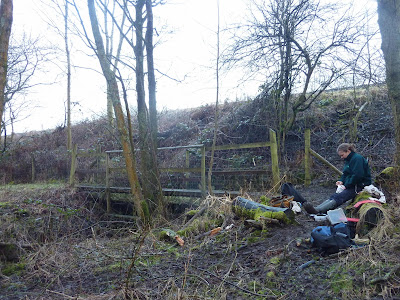Present: JAF, KW
Next Ness is a small boggy woodland strip (mainly alders and willow) running parallel to the railway line. It is owned and managed by the Cumbria Wildlife Trust, to whom we are grateful for permission to ring there. The wood is habitat for Teal, Moorhen, Kingfisher, Siskin and various tits and finches.
Today we processed 24 birds, of which 19 were new (retraps in brackets):
Wren 1 (0); Coal Tit 1 (1); Blue Tit 8 (3); Great Tit 3 (1); Chaffinch 4 (0); Bullfinch 2 (0).
 Next Ness CWT Nature Reserve is the strip of woodland alongside the railway line.
Next Ness CWT Nature Reserve is the strip of woodland alongside the railway line.
The approximate position of the feeding station is arrowed.  There is just one site where a 120-foot net can be stretched across
There is just one site where a 120-foot net can be stretched across
the swampy woodland through the tangle of willow and alder
 The improvised field station at Next Ness Nature Reserve
The improvised field station at Next Ness Nature Reserve
Present: JAF
Another attempt yesterday at the House Sparrows was thwarted by noisy children playing in the park during Half Term. Why couldn't they go somewhere else?
Ringed: Blackbird 2; Song Thrush 1; Greenfinch 1; Bullfinch 1; House Sparrow 3.



























